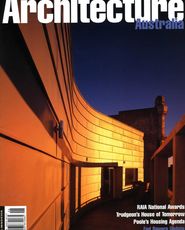“Architecture seems to be getting short shrift from two Australians who should know better; namely Messrs kel Hutchence and John Howard”
–Ronald Corlette, Theuil, Paris.
| Scheme Anticipated
I should like to draw your attention to an
inaccuracy in your highly informative Radar
Headlines commentary (AA September/
October 98), which I always enjoy reading.
It concerns the Buzacott Caro King Street
footbridge. The Darling Harbour Authority
was fully informed about the “unanticipated
wharves development” on Darling Harbour
9 and 10 well before this bridge was
constructed; however, for its own reasons
chose to proceed. The footbridge, nicely detailed though it is,
successfully manages to block the last view
of Darling Harbour’s water from a city street
(down King Street), carrying on a fine MSB,
RTA, DHA and Monorail tradition.
The wharves development, on the other
hand, requires King Street to be extended,
uninterrupted by view-blocking structures, to
the waterfront. It is also worth noting that the “unanticipated
wharves redevelopment” has been planned
to open up other views to the water from the
public domain. These will, no doubt in the future, become
available for blocking by some fine public works. –From David Chesterman, Sydney
No Loss
The brevity of Radar Headlines (AA
September/October 98) is no excuse for
inaccuracy. “Paul Downton’s Urban Ecology
Group” did not “lose its pitch to the city council”. Urban Ecology Australia—a community, non-profit,
national organisation run entirely by
volunteers—has succeeded in catalysing the
creation of what promises to be a leading
example of ecological development in
Australia in a state infamous for its inaction
and lack of vision. We think that’s a pretty
positive achievement. And Adelaide City
Council is now completely committed to a
full remediation of this very polluted site,
something that UEA has campaigned for
over six years. In addition, UEA and Ecopolis
(of which I am the architect director) have
already been commissioned by Pentroth to
work with them on environmental
technologies and processes associated with
the proposed development of Adelaide’s
Halifax Street depot site (not a ‘town’ for
goodness sake—this is for a site within the
city’s Square Mile!). Hansen Yuncken and Alpine Constructions
had put together a bid to the Adelaide City
Council which was not given the final
imprimatur of Urban Ecology Australia before
being lodged. Unfortunately, it was this
document on which the tenders were, quite
properly, assessed. (UEA had also
successfully campaigned for an open, accountable selection adopted by council.) The council concluded that that final
submission by those developers
(co-ordinated by Hansen Yuncken) did not
fully address every aspect of its demanding
brief—a brief which reflected in almost
every respect the EcoCity vision promulgated
by UEA since 1992. Urban Ecology did not ‘win’ a bid to develop
the Halifax site—but it did not lose either! –From Paul F. Downton, Adelaide
Get Fit
After reading the Queensland section of
‘Headlines’ in Architecture Australia’s
September/October edition, I feel that the
criticism of “privileging the young and fit”
with regard to the Brisbane City Council’s
Riverwalk 2000 scheme is inappropriate.
While few (if any) schemes are ever perfect
in every way, credit should be given to
initiatives such as this one, which seek to
encourage a healthier lifestyle. Perhaps this should be seen as an
opportunity for individuals who are not as
fit as others among us, to raise their level of
personal fitness, even if they are not young
as such! –From Jeremy Haldane, Taringa, Queensland
| Congratulations
Congratulations on your latest
September/October issue which presented
an outstanding collection of fine works of
new Australian architecture, shown in
beautiful photographs by Patrick Bingham-Hall
and Simon Kenny. It was good to see Queensland architect Rex
Addison back in the limelight with his subtle
and well-crafted backyard studio. I also admired the archery pavilion by
Stutchbury and Pape and the Tranby College
extensions by Cracknell Lonergan. Although
these projects are very different from each
other, they both seem to suggest that public
buildings will be in good hands with these
up-and-coming members of the Sydney school. There was less to appreciate in the gaudy
computer images you showed of concepts
for Melbourne’s Docklands—a most
important renewal program which still seems
confused, as was indicated by your writer
Anthony Styant-Browne. In general, this was the most satisfying
Architecture Australia that I have received for
some time. –Janet Wetherill, Sydney
Should Know Better
Architecture seems to be getting short shrift
from two Australians who should know
better; namely Messrs Kel Hutchence and John Howard. I quote both in commenting on ‘the Toaster’
at East Circular Quay. The former: “It’s
disgusting … that we have this ugly piece of
architecture sticking up so near to probably
the greatest building built this century” and
the latter: “The idea that we should take
money away from other people in Australia
to tear down an architectural monstrosity …”
Nikolaus Pevsner, may his tribe increase,
began his great work An Outline of European
Architecture with the words “a bicycle shed
is a building; Lincoln Cathedral is a piece of architecture.” How I wish the two previously mentioned
gents were as precise in their language. –Ronald Corlette Theuil, Paris
Supine Attitude
Michael Peck’s dismissal of Feiko Bouman’s
charge that the RAIA is controlled by a
‘rotating cartel’ of large firms (AA
September/October 98) is wrong. The RAIA
was set up to promote the interests of the
architectural establishment, and it would be
surprising if it did otherwise. Thanks in no small part to the supine
attitude of the RAIA, individual architects and
the profession of architecture have virtually
no public credibility left, especially in NSW.
A bit of hand-wringing over fiascoes such as
Walsh Bay or East Circular Quay is all that
the office holders of the Institute in NSW
ever manage, and given the way in which
the RAIA is structured, that is all that we can
really expect. This must be a sore
disappointment to the majority of members
who are genuinely concerned about the
future of the built environment and have no
interest in comforting firms which assist
others to destroy it. If the RAIA is ever to become a successful
advocate for the built environment, it must
confront the fact that this will inevitably
involve a clash of interests with those firms
and individuals that now dominate the
profession. I am sure the ‘cartel’ will fight
tooth and nail to stop the Institute becoming
a public voice which may criticise them and
their work, but I’m equally sure that many
architects would welcome this fight. –From Geoff Hamner, Crows Nest, NSW
We welcome your concise views on issues of
interest to architects. Please provide contact
details; we may need to edit. The RAIA’s
CEO, Michael Peck, has right of reply to
letters criticising the Institute. Address
correspondence to Architecture Media at
4 Princes Street, Port Melbourne, Victoria
3207. Fax (03) 9646 4918. Or email us at
|















